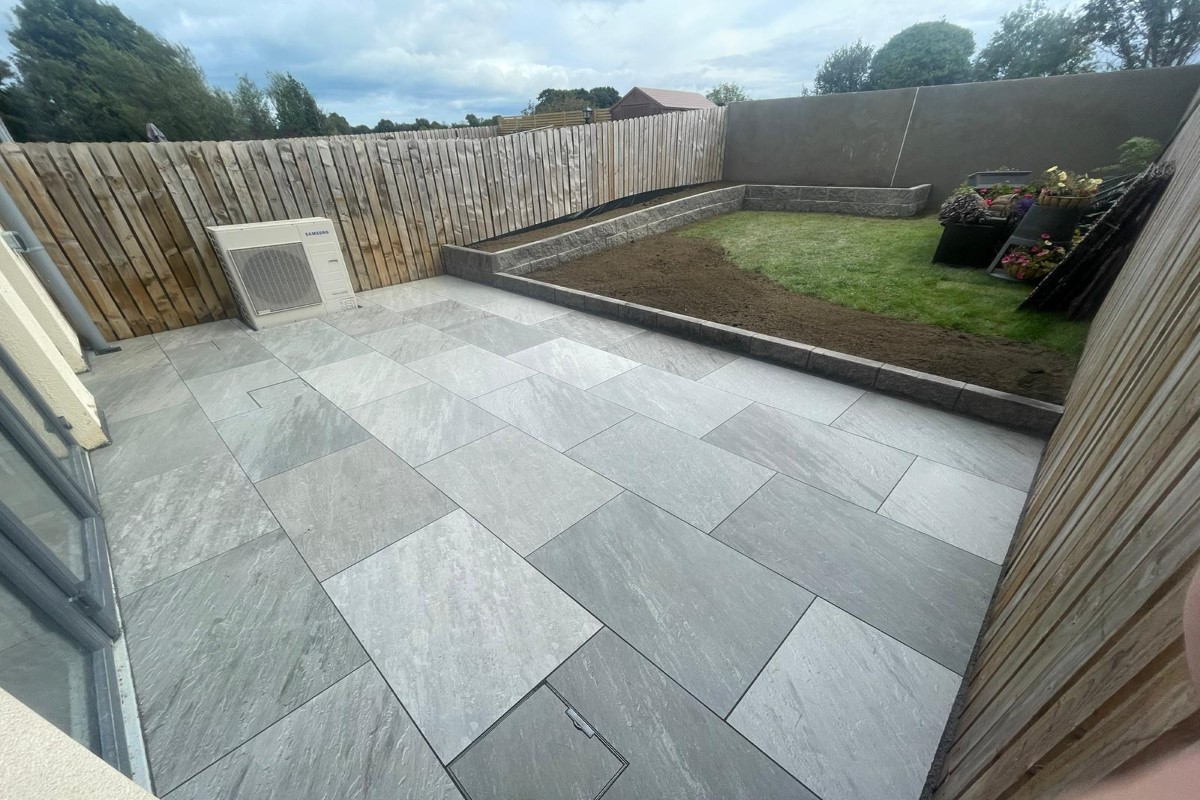
Choosing the right slabbing style is crucial when crafting the perfect garden or patio. Patio slabs are the foundation of outdoor aesthetics, offering beauty and practicality. Each material presents a unique flair, from the sleek, contemporary porcelain finishes to the timeless elegance of natural stone.
Naturalscape Paving understands the importance of selecting a patio style that resonates with your taste and the functionality of your space. They offer a diverse range of common patio slabbing styles, ensuring there's a match for every garden. Whether it's the versatility of concrete or the sophistication of limestone, the right choice can transform your outdoor area into a serene retreat.
For the full range of our services, check out our patio services in Leinster or you can contact us on (01) 5768874 to speak directly with one of our team.
Indian Sandstone Paving Slabs
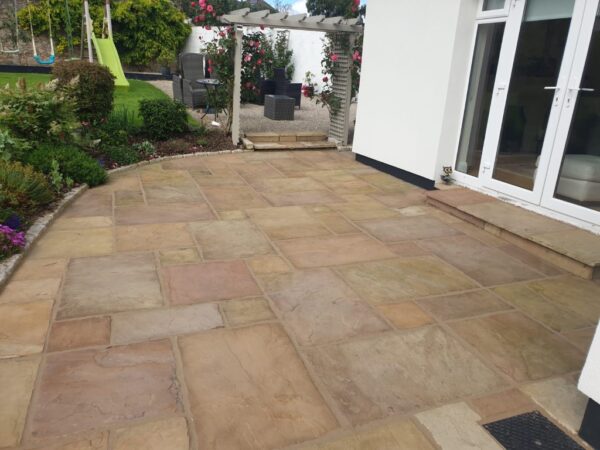
Benefits of Indian Sandstone
Indian Sandstone paving slabs are renowned for their extreme durability, withstanding the test of time in outdoor environments. Homeowners appreciate the wide range of colours and styles, from muted greys to vibrant hues, ensuring that each garden or patio can reflect individual tastes with the perfect end product. The versatility of Indian Sandstone is further evident in its weather-resistant properties, being naturally slip-resistant; it’s a dependable choice in wet or frost-prone areas.
Another significant advantage is the ease of maintenance. Indian Sandstone is easy to clean; a simple soapy water solution will suffice to maintain its pristine appearance. Moreover, because of its popularity, Indian Sandstone is widely available, so finding the ideal slab is rarely challenging. Most paving shops stock a substantial range of Indian Sandstone options, allowing for a broader selection.
Despite the potential for a rough surface due to the stone's natural texture, it's a minor drawback compared to the benefits. And while the surface can get scratched over time, these marks tend to diminish naturally.
| Key Qualities | Description |
|---|---|
| Extreme Durability | Resilient against wear and weather |
| Range Of Colours & Styles | Offers versatility for design preferences |
| Weather Resistance | Slip resistant and performs well in harsh conditions |
| Easy Maintenance | Simple cleaning with soapy water |
| Availability | Accessible from most suppliers |
When selecting Indian Sandstone, it's essential to consider the individual nature of each slab. Unlike machine-made alternatives, every piece of natural sandstone is distinct, boasting unique patterns and textures. This variety ensures that no two patios will look the same, adding an exclusive charm to the property. As with any natural product, working with Indian Sandstone requires care. The slabs are generally easy to work with, including cutting and laying. However, the varied texture can pose a challenge for consistency. Acknowledging that natural stones command attention to detail during installation to ensure longevity and stability is critical.
Limestone Paving Slabs
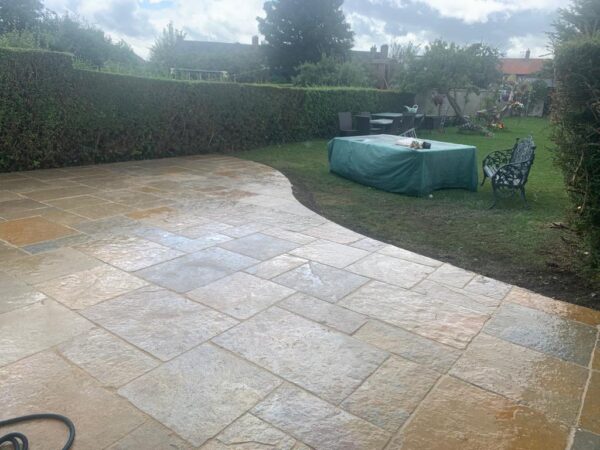
Benefits to Limestone Slabbing
Limestone paving slabs are renowned for their durability and longevity. Garden enthusiasts and professional landscapers alike appreciate limestone for its hardy nature, providing a reliable foundation that withstands the test of time. With limestone, there's the added assurance of safety; its naturally non-slip and frost-resistant surface makes it an ideal choice for outdoor areas used throughout the year.
The aesthetic appeal of limestone is unmatched, offering a range of stunning shades that can effortlessly elevate the visual aspect of any garden. These shades vary from soft, subtle creams to rich, deep greys, enabling them to blend seamlessly with various outdoor designs and themes.
Another notable benefit of using limestone for paving slabs is its eco-friendly attribute. As a natural stone, limestone doesn't emit harmful substances into the environment, marking it as a responsible choice for those conscious about their ecological footprint.
Due to the material’s fine texture, working with limestone slabs is straightforward. Its ease of cutting allows for a tailored approach, ensuring that the slabs fit precisely according to bespoke garden plans.
Limestone's ability to weather naturally over time contributes to its charm; aging slabs tend to develop a character that further enhances the traditional look of a garden space. This ageing process is an aesthetic benefit and ensures that the slabs remain congruent with the evolving landscape of a traditional setting.
| Benefits | Details |
|---|---|
| Durability | Limestone paving slabs are resistant to wear and tear and are well-suited to high-traffic garden areas. |
| Non-Slip & Frost Resistant | Safe for use throughout the year including winter months. |
| Variety of Shades | Multiple colours available to match garden aesthetics. |
| Eco-Friendly | A renewable resource with minimal environmental impact. |
| Easy to Cut | Can be shaped to specific dimensions for custom garden designs. |
Despite its many advantages, limestone does have a few downsides. Over time, the vibrant colours of limestone may begin to fade if the stone isn't properly cared for. Preventative treatments and regular maintenance are advised to minimise this risk.
Porcelain Paving Slabs
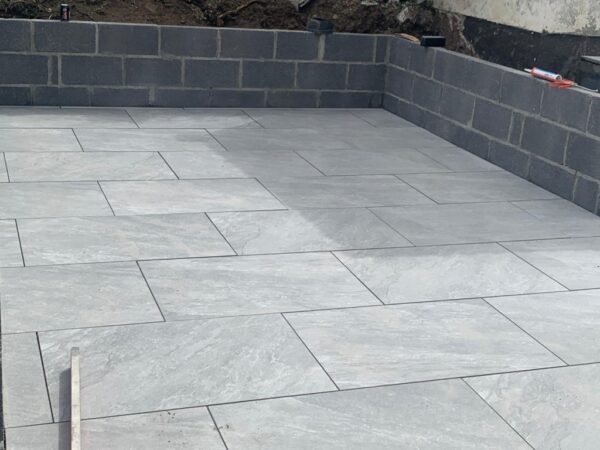
Benefits to Porcelain Tiling
When deliberating over the plethora of paving options for patios, it's becoming increasingly clear that porcelain paving slabs are gaining traction among homeowners and designers alike. What sets porcelain apart from its natural stone counterparts is a combination of practical features and aesthetic versatility.
First and foremost, porcelain paving is non-porous. This innate characteristic means the tiles are impervious to liquid absorption, warding off water damage and simplifying upkeep. They're incredibly low maintenance, requiring minimal effort to retain their pristine condition. A simple wash once or twice a year suffices, allowing more time to enjoy the outdoor space rather than maintain it.
For durability, porcelain patios as a manufactured product, are unsurpassed. The high-temperature firing process creates a highly durable product that stands the test of time. Additionally, the frost-resistant nature of porcelain means these slabs resist the winter chill, reducing the risk of cracking and ensuring a safer surface during colder months.
The design flexibility of porcelain paving cannot be overstated. With the advent of technological advancements in printing, porcelain can emulate the look of natural stones such as granite, limestone, sandstone, and wood effects, offering a versatile palette for any garden or patio theme.
Beyond aesthetics, practical benefits amplify the stone's appeal. Not only is the material easy to work with, but it also provides a uniformity often desired for sleek and modern outdoor designs. Each slab is identically shaped thanks to precise manufacturing processes, resulting in a clean and consistent finish throughout the laid area.
| Feature | Benefit |
|---|---|
| Non-Porous | Prevents water damage and easy to clean |
| Low Maintenance | Minimal upkeep required |
| High Durability | Long lifespan and able to withstand heavy usage |
| Frost Resistant | Safe and less slippery during cold weather |
| Design Versatility | Emulates different textures and styles |
Granite Paving Slabs
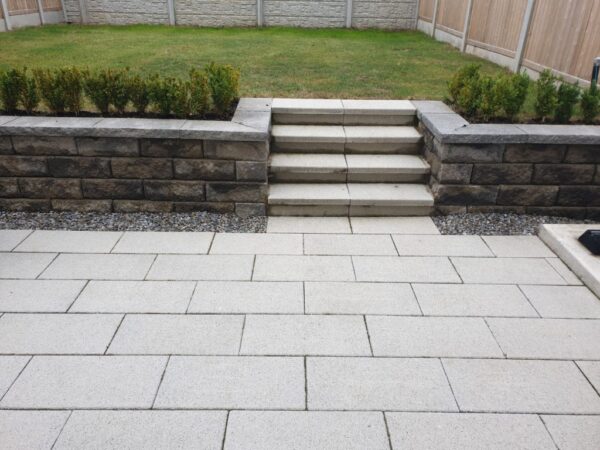
Granite is a distinctive choice due to its igneous origins, which imbue it with unparalleled durability. Quartz and feldspar, the predominant minerals that form granite through the crystallization of magma beneath the earth's surface, are renowned for their resilience. The hard-wearing nature of these minerals makes granite an exceptional material for paving slabs.
Granite slabs have many colours and finishes, from pristine whites to deepest blacks. Their aesthetic is further enhanced by various surface treatments, with flaming or leathered finishes contributing to a plethora of visual effects. Granite's toughness translates to a precise and clean cut, resulting in a product with six sawn sides and a refined appearance.
The unique composition of granite, with feldspar content ranging from 65% to 90% and quartz constituting 10% to 60%, leads to an impressive spectrum of colours and finishes. This variability allows granite to cater to diverse style preferences.
Practical Considerations
Despite being lauded for its robustness, granite paving does require consideration before installation. Its density and hardness can make alterations a challenging task—should cutting become necessary. Those laying granite slabs must be ready for a labour-intensive effort due to the weight of the material.
Yet, the initial hard work pays off with granite's minimal maintenance requirements and its ability to withstand the test of time. Granite is virtually impermeable to water with porosity levels starting at a mere 0.2%. It also exhibits high thermal stability, ensuring no significant change in appearance even with temperature fluctuations.
Homeowners willing to invest in premium paving will find that granite's style and longevity justify its cost. Once installed, its steadfast nature means that granite paving remains steadfastly in place, underlining both its practicality and enduring elegance.
Block paving for patios
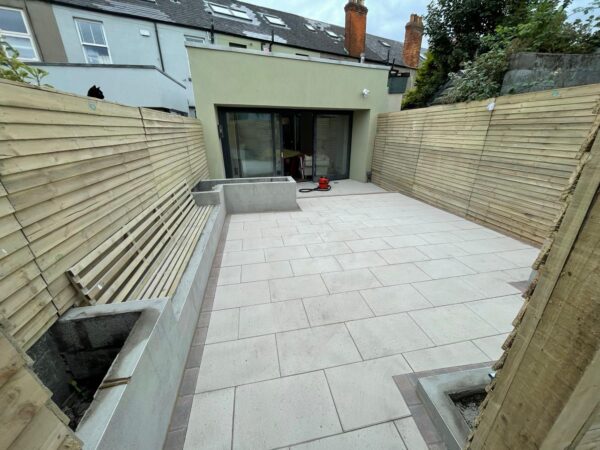
Benefits of Patio Paving
When creating a stylish and inviting patio, block paving offers flexibility in design and durability. Unlike monolithic paving solutions, block paving consists of individual bricks or stones, which can be laid in various patterns to achieve the desired aesthetic. This style of paving is renowned for its ability to withstand heavy traffic, making it a practical choice for both residential and commercial spaces.
The individual blocks allow for easy replacement and repairs, which is more cost-effective over the long term. Homeowners can replace a small section without needing to overhaul the entire patio. Moreover, block paving's porous nature ensures proper drainage, reducing the risk of water pooling and prolonging the lifetime of the patio.
The right maintenance regimen can effectively manage weed prevention in block paving, ensuring that the patio remains pristine. Incorporating long-aspect plank or wood-effect paving can add uniqueness and character that traditional slabs might not provide, as seen with ranges such as Belvedere and the Classic flag from Kilsaran in Dublin.
Maintenance is an inherent part of block paving; however, it's a manageable task that ensures the structure's longevity. Routine cleaning and occasional re-sanding of the joints will keep the patio looking sharp and inhibit weed growth.
Choosing from various colours and finishes, homeowners can find block paving that complements their garden design, with the added benefit of mixing colours and patterns for a custom look. Its versatility also makes it suitable for creating intricate designs or simple borders that enhance the overall appearance of the garden space.
Despite the benefits, it's important to note that block paving may require sealing, especially to combat weed growth between the blocks. However, advancements in materials like porcelain blocks offer alternatives that negate this requirement entirely.
The nature of block paving also means some joints could potentially harbour weeds and moss. Addressing this involves regular sealing and maintenance, but the advantages of adaptability and the potential for unique designs contribute to its popularity as a choice for patios.
Concrete Slabs
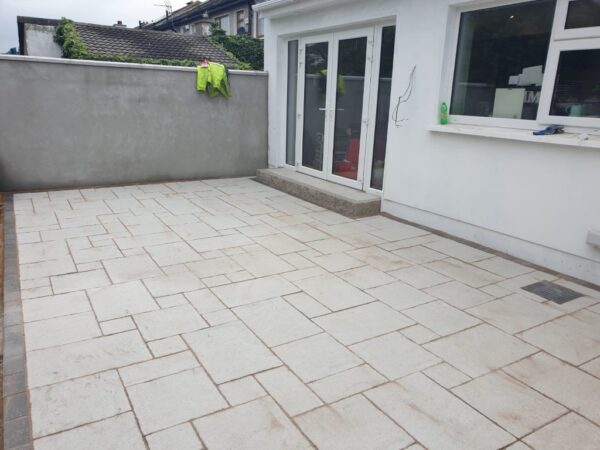
Benefits to Concrete Slabbing
Concrete slabs are a robust option for patio surfacing, offering durability that withstands various elements. Their resilience under frequent foot traffic makes them suitable for outdoor spaces, whether for family activities or entertainment purposes. Unlike other materials, concrete requires minimal upkeep, translating to low maintenance costs and hassle-free enjoyment for homeowners.
The uniform colour, finish, and thickness provided by the manufacturing process afford consistent quality and ease of installation, a boon for those looking to tackle patio projects as weekend DIY endeavours. The colourful array of options now available extends the potential for concrete slabs to blend with different architectural styles harmoniously. What was once a grey-only product has evolved, presenting homeowners with a palette of colours to enhance their outdoor aesthetic.
Regarding measures of practicality and aesthetics, the versatility of concrete slabbing cannot be understated. It can deliver the classic look desired by many, with newer styles and advancements in texture and edge design catering even to contemporary tastes. Pressed concrete slabs, known for their more uniform texture and straight edges, are further evidence of the material's adaptability. While wet-cast concrete slabs feature a chamfered edge, pressed concrete is prized for its cleaner lines and defined silhouette.
The manufactured nature of concrete slabs means they are often budget-friendly, providing an economically accessible option for revamping garden and patio areas. With products like Bradstone's Textured Paving offering a modern twist on traditional styles, the material continues to be popular, signposting current trends without a high price tag. It's an opportunity for property owners to elevate their exteriors without compromising quality or enduring appeal.
Despite its many positives, the choice of concrete as a patio surface should be informed by considerations of the environment it's to inhabit. While it is hard-wearing, fading can occur, particularly with coloured varieties, under prolonged exposure. However, the ease with which damaged slabs can be replaced mitigates longevity concerns, ensuring a pristine patio is maintainable over the years.
What Patio Style Should I Choose?
Choosing the right patio slabbing style balances aesthetics, practicality, and budget. Concrete slabs are a versatile and economical choice that meets many needs. They're tough enough to handle the hustle and bustle of outdoor living and flexible enough to match your home's character. While they might fade over time, the ease of maintenance and replacement makes them a favourite for many homeowners. When selecting the perfect patio style, consider how concrete slabs could elevate your outdoor space functionally and visually.
Frequently Asked Questions
How can I make my patio slabs look better?
To improve the appearance of your patio slabs, consider painting them, laying decking flooring, adding curves with pavers, installing slate tiles, staining the concrete for a tiled effect, decorating with an outdoor rug, painting the concrete creatively, or beautifying the area with plants and decor.
How do you make slabs look nice?
Making your slabs look nice can be achieved through several methods: using outdoor floor paint, adding an outdoor rug, decorating with flowers and plants, laying new paving stones for a fresh look, or installing artificial grass for a touch of greenery without the upkeep.
What is the best shape for a patio?
A rectilinear patio is the most popular and adaptable shape, offering ease of construction and a contemporary aesthetic. Square or rectangular patios are often preferred as they readily accommodate a variety of paver styles.
What type of patio is most durable?
Natural stone, especially granite slabbing, will always be the most durable in hard-wearing aspect and colour. Of the manufactured products, porcelain tiling easily wins as it's a very hard-wearing product with very durable colours.
What are the three different types of concrete slabs available?
There are three primary types of concrete slabs: on-ground slabs, which rest directly on the earth; suspended slabs, which are raised above ground level; and mixed forms that incorporate elements of both. Insulation of concrete slabs must be considered to meet climate needs.
WE OFFER 100% FREE ESTIMATES
HIGHLY RATED & LOCAL COMPANY
WE USE ONLY THE FINEST PRODUCTS